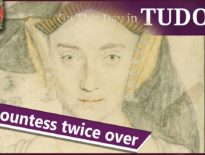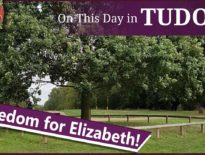On this day in history, 19th October 1469, an event took place in Spain that was not only important in Spanish history, but which had an impact on Europe and which has links with the Tudors.
The event was the marriage of an eighteen-year-old woman called Isabella and a seventeen-year-old man called Ferdinand. They'd become the famous Reyes Catolicos, the Catholic monarchs, Isabella I of Castile and Ferdinand II of Aragon, and would bring together two powerful kingdoms, which comprised most of what is modern-day Spain.
In today's talk, I tell you more about this powerful couple, their reigns and their legacy.
Also on this day in Tudor history, 19th October 1536, the Pilgrimage of Grace Rebellion in the north of England was well underway, and King Henry VIII had come to the decision that tough action was needed to put it down. The action he ordered wasn’t just tough, it was downright brutal, and you can find out more about it in last year’s video:
Also on this day in history:
- 1512 – Reformer Martin Luther was awarded his Doctorate of Theology from the University of Wittenberg.
- 1592 – Death of Anthony Browne, 1st Viscount Montagu, courtier and member of Parliament, at his manor of West Horsley, Surrey, He was buried at Midhurst. Montagu served Mary I as an ambassador and Privy Councillor, and Elizabeth I as Lord Lieutenant of Sussex.
Transcript:
On this day in history, an event took place in Spain that was not only important in Spanish history, but which had an impact on Europe and which has links with the Tudors.
For, on 19th October 1469, in the Palacio de los Vivero in Valladolid, in what is now Castile and Leon, in Spain, a couple who would become the famous Reyes Catolicos, the Catholic monarchs, got married.
The bride was eighteen-year-old Isabella, daughter of John II of Castile and Isabella of Portugal, and the groom was seventeen-year-old Ferdinand, son of John II of Aragon and Juana Enriquez. The couple were second cousins, both being descended from John I of Castile.
Isabella wasn’t supposed to marry Ferdinand. Her half-brother, Henry IV of Castile, had negotiated several matches for her even after he had named her heir presumptive and promised that he wouldn’t force her to marry against her wishes. Most recently, in 1468, Henry had been arranging a match between Isabella and his brother-in-law Alfonso V of Portugal and then Charles, Duke of Berry, brother of King Louis XI of France. Isabella was against the idea, preferring Ferdinand, to whom she’d been betrothed when she was just six years old. Isabella corresponded with John II of Aragon and secretly promised to marry Ferdinand. Cardinal Rodrigo de Borgia, the future Pope Alexander VI, helped the couple to obtain a dispensation from the Pope to cover the fact that they were related within the prohibited degrees of consanguinity, and then Isabella left court, pretending that she was going to visit her brother’s tomb in Ávila. Instead, she met up with Ferdinand, who had disguised himself as a servant. They married on this day in 1469.
Isabella became Queen Isabella I of Castile in 1474, following the death of her half-brother, and Ferdinand became King Ferdinand II of Aragon in 1479, following his father’s death. Their marriage was an important one, for it united the powerful kingdoms of Aragon and Castile, a vast territory which comprised most of what is modern-day Spain.
They didn’t have things easy though. Isabella had to deal with plots against her and war over the succession, but she remained queen and reigned until her death in November 1504. Ferdinand remarried in 1506, taking Germaine de Foix, niece of King Louis XII of France, as his wife. He died in January 1516.
Here are a few more facts about this powerful European couple:
• They had seven children, five of whom survived childhood. They included Joan of Castile, also known as Juana la Loca or Joanna the Mad, and Catherine of Aragon, who married Arthur Tudor, eldest son of King Henry VII, and then Henry VIII. All five of their surviving children married heirs of European kingdoms.
• Their grandchildren included Holy Roman Emperors Charles V and Ferdinand I, and Queen Mary I of England. Charles V ruled a vast empire, inheriting rule of the European Holy Roman Empire from his grandfather Maximilian I, the Netherlands from his father, Philip the Handsome, and Spain from his mother Juana.
• Ferdinand and Isabella are known for their completion of the Reconquista which saw the forced conversion of Jews and Muslims in Spain and the expulsion of others. In 1492, they conquered Granada, the last Muslim Nasrid kingdom in mainland Spain. In recent times, the Spanish government has offered Spanish citizenship to Jews whose families were expelled in the 15th century when they were given the choice to covert, leave or die. Somewhere between 40,000 and 100,000 Jews are thought to have been expelled.
• They founded the Spanish Inquisition, or the Tribunal of the Holy Office of the Inquisition to give it its full name, in 1478. It sought to identify heretics and to regulate the faith of those converted from Judaism and Islam in their kingdoms.
• Pope Alexander VI gave Ferdinand and Isabella the title Los Reyes Catolicos, the Catholic Monarchs for their work against the Jews and Muslims.
• They sponsored the 1492 voyage of Christopher Columbus, or Cristóbal Colón as he’s known in Spain, which saw him discovering the New World and claiming it for Spain.
• The couple restored finances and made government and administrative reforms in their kingdoms.
• The couple’s resting place is the Capilla Real in Granada, and their beautiful tomb can be visited there today.
I often wonder what Isabella would have thought of King Henry VIII’s treatment of her daughter, Catherine of Aragon, and her granddaughter, Mary. She would not have been impressed.



Leave a Reply